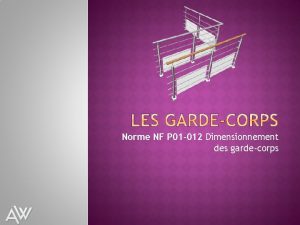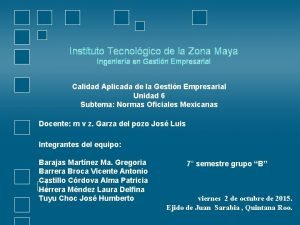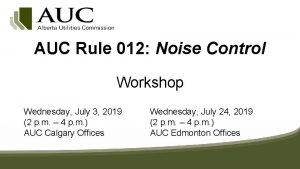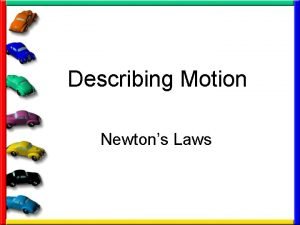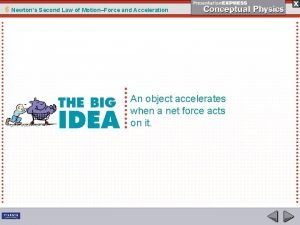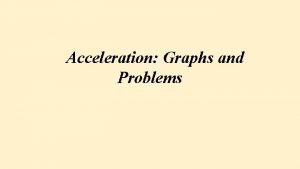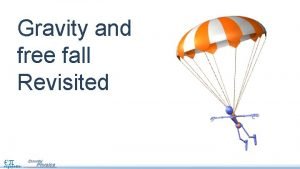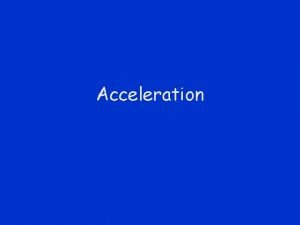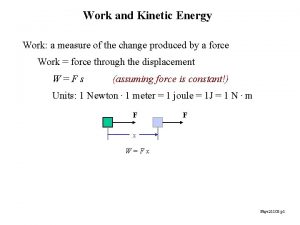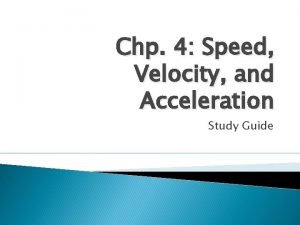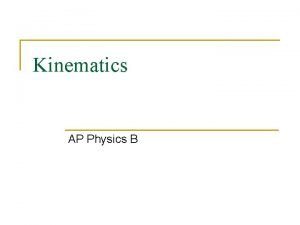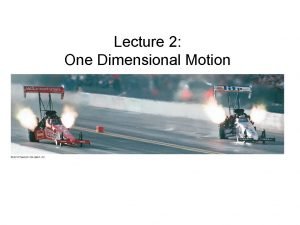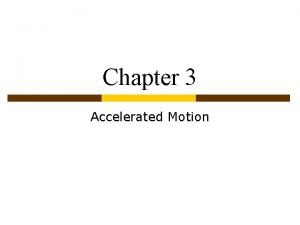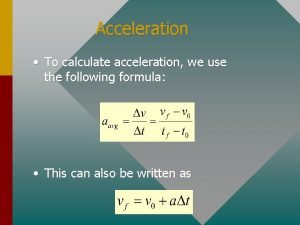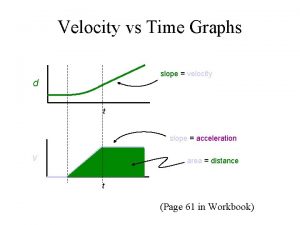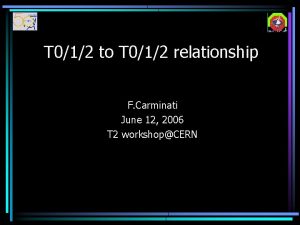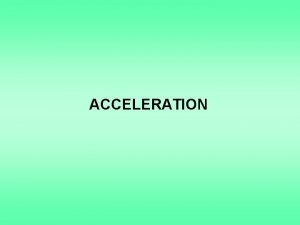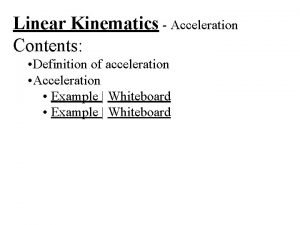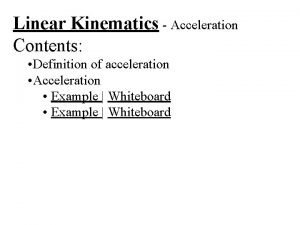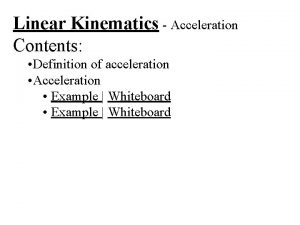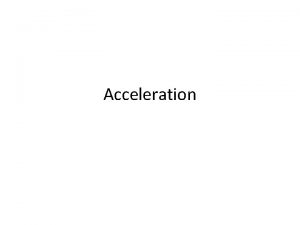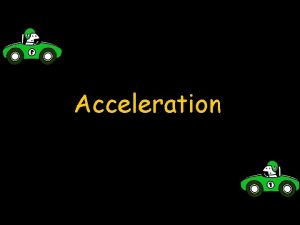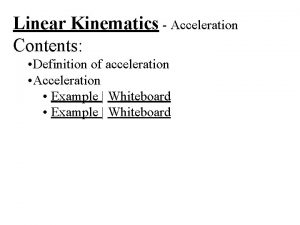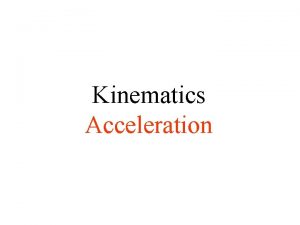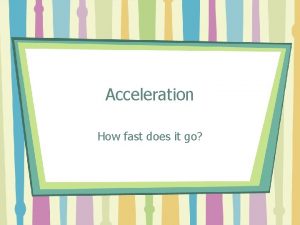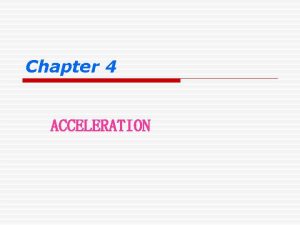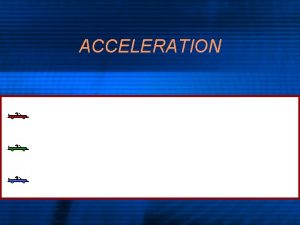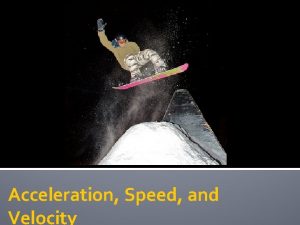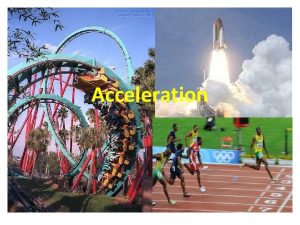Acceleration 012 10997 r 1 04 Acceleration 012



























- Slides: 27

Acceleration 012 -10997 r 1. 04

Acceleration 012 -10768 r 1. 04

Acceleration Introduction Journals and Snapshots The Snapshot button is used to capture the screen. The Journal is where snapshots are stored and viewed. The Share button is used to export or print your journal to turn in your work. Each page of this lab that contains the symbol should be inserted into your journal. After completing a lab page with the snapshot symbol, tap (in the upper right corner) to insert the page into your journal. Note: You may want to take a snapshot of the first page of this lab as a cover page for your journal.

Acceleration Lab Challenge • What does it mean to decelerate? • What does it mean to accelerate?

Acceleration Background • Acceleration is the rate at which the velocity of an object changes. velocity final – velocity initial time = acceleration • Since velocity is the speed and direction of an object's motion, acceleration can mean speeding up, slowing down, or changing direction.

Acceleration . . . Background • A car can have a positive acceleration when it is speeding up and a negative acceleration when it is slowing down depending on its direction of travel. • When a car is speeding up, its acceleration is in the same direction of its velocity: both acceleration and velocity are positive or negative. When a car is slowing down its acceleration is in the opposite direction of its velocity: velocity and acceleration have opposite signs.

Acceleration . . . Background • Constant acceleration means that an object's velocity is changing at an uniform rate. • For example, when you throw a ball into the air it experiences a velocity change of 9. 8 m/s every 1 second. Since the acceleration's direction is pointing towards the Earth, the ball will decelerate (slow down) when moving up and accelerate (speed up) when falling down.

Acceleration Self-Check 1. When a car's acceleration is negative but its velocity is positive, the car is: a) slowing down b) speeding up c) maintaining constant speed d) undefinable

Acceleration Self-Check 2. Does a cart rolling freely up and then back down an inclined track illustrate constant acceleration? Justify your answer.

Acceleration Materials and Equipment Collect all of these materials before beginning the lab. • Motion Sensor • Cart with Plunger • Track End Stop • Track Pivot Clamp • Dynamics Track • Rod and Base Note: Angle indicator not used in this lab

Acceleration Sequencing Challenge A. Repeat data collection, this time pushing the cart up the inclined track toward the motion sensor. B. Determine the cart's acceleration from each trial using the slope of the graphed data. C. Release the cart from the elevated end of the track to produce a velocity versus time graph. D. Assemble the inclined track with the end stop at one end and the motion sensor at the opposite end. The steps to the left are part of the procedure for this lab activity. They are not in the right order. Determine the correct sequence of the steps, then take a snapshot of this page.

Acceleration Setup 1. Attach the End Stop to the lower end of the Dynamics Track. 2. Mount the track to your rod and base using the pivot clamp, slightly inclining the track at one end. 3. Attach the Motion Sensor to the elevated end of the track with the face of the sensor pointed down the length of the track. 4. Connect the Motion Sensor to the SPARK Science Learning System. Note: Make certain the switch on the top of the motion sensor is set to the cart icon.

Acceleration Collect Data 1. Set the cart at the top of the inclined end of the track holding it ~15 cm from the Motion Sensor. 2. Tap to begin data collection. 3. Release the cart allowing it to roll down the track. 4. Catch the cart at the bottom of the inclined track just before it hits the end stop. 5. Tap to stop data collection.

Acceleration Collect Data 6. Set the cart at the bottom of the inclined track against the end stop. 7. Tap to begin data collection 8. Using your hand, push the cart up the inclined track (avoid hitting the motion sensor) allowing it to roll back down. 9. Again, catch the cart just before it hits the end stop. 10. Tap to stop data collection.

Acceleration Analysis 1. During the period when the cart was in motion, are the velocity versus time graphs straight lines? Refer to the previous page if necessary. How is the acceleration of the cart changing if your velocity versus time graphs are straight lines?

Acceleration Analysis 2. Although the paths of the cart in both trials were different, the slopes of the velocity versus time graphs for each trial are the same (during the period in which the cart was in motion). Why is the case? Justify your answer.

Acceleration Analysis 3. Looking at the velocity versus time graph, what would a negative slope tell you about the cart's acceleration? A positive slope?

Acceleration Analysis 4. What was causing the cart to accelerate after releasing it from rest at the top of the track? Was that acceleration constant?

Acceleration Analysis 5. Describe the motion of an object whose velocity versus time graph is a horizontal straight line (a slope of zero).

Acceleration Synthesis 1. The term "acceleration" is used in our everyday lives and language, but is often used in a non-physical context. Now that you have developed a physical definition of "acceleration" give an example where the physical definition matches the "everyday" definition. Give an example where they are different.

Acceleration Synthesis 2. Modern aircraft carriers use a steam powered catapult system to launch jets from a very short range. These catapults can provide a constant acceleration to bring jets up to speed in only 2 seconds. If each jet requires a minimum takeoff speed of 82. 3 m/s, how much acceleration must the catapult supply so the jet can take off?

Acceleration Synthesis 3. How many different devices in a car help to accelerate the vehicle? What are they?

Acceleration Multiple Choice Question 1. If the acceleration due to gravity is -9. 8 m/s 2, which of the following choices would best describe the acceleration of a 0. 5 kg frictionless block sliding down the track used in our experiment? a) -3. 5 m/s 2 b) 3. 5 m/s 2 c) 0 m/s 2 d) Undefinable

Acceleration Multiple Choice Question 2. A cart with an initial velocity of zero and a final velocity of 12 m/s after 2 s will have an acceleration of a) 4 m/s 2 b) 6 m/s 2 c) 8 m/s 2 d) 12 m/s 2

Acceleration Multiple Choice Question 3. A race car starting from rest accelerates uniformly at a rate of 5 m/s 2. What is the car's speed after it has traveled for 5 s? a) 5 m/s b) 10 m/s c) 20 m/s d) 25 m/s

Acceleration Congratulations! You have completed the lab. Please remember to follow your teacher's instructions for cleaning-up and submitting your lab.

Acceleration References ALL IMAGES WERE TAKEN FROM PASCO DOCUMENTATION, PUBLIC DOMAIN CLIP ART, OR WIKIMEDIA FOUNDATION COMMONS: http: //commons. wikimedia. org/wiki/File: 070825 -N-3271 W-004. jpg http: //commons. wikimedia. org/wiki/File: Stapp. Sled. jpg http: //commons. wikimedia. org/wiki/File: Rocket_sled_track. jpg http: //commons. wikimedia. org/wiki/File: F-14 D_Tomcat_on_USS_John_C. _Stennis. jpg http: //commons. wikimedia. org/wiki/File: FA-18 -Decollage. jpg http: //commons. wikimedia. org/wiki/File: Paul_Menard, _Homestead-Miami_2006. jpg http: //upload. wikimedia. org/wikipedia/commons/1/14/F-15_takeoff. jpg http: //commons. wikimedia. org/wiki/File: Ford_BA_Falcon_GT_-_Targa_Tasmania. jpg http: //www. freeclipartnow. com/office/paper-shredder. jpg. html
 Radial acceleration
Radial acceleration Kinetic angular energy
Kinetic angular energy Centripetal force
Centripetal force Centripetal acceleration tangential acceleration
Centripetal acceleration tangential acceleration Angular quantities
Angular quantities Pchw 012
Pchw 012 Nit dicla 031
Nit dicla 031 Circular 012 pamec excel
Circular 012 pamec excel Ioit-012
Ioit-012 Nfp 01 012
Nfp 01 012 Nom-012-scfi-1994
Nom-012-scfi-1994 Auc rule 012
Auc rule 012 Law of acceleration
Law of acceleration Law of force and acceleration
Law of force and acceleration Calibrated alt
Calibrated alt Acceleration sentence
Acceleration sentence Free fall formula
Free fall formula What does a negative acceleration indicate
What does a negative acceleration indicate Radial acceleration
Radial acceleration Velocity
Velocity Kinetic energy with acceleration
Kinetic energy with acceleration Speed velocity and acceleration study guide answers
Speed velocity and acceleration study guide answers Kinematics all formulas
Kinematics all formulas What does a negative acceleration indicate
What does a negative acceleration indicate Acceleration
Acceleration Motion section 3 acceleration
Motion section 3 acceleration How to calculate acceleration
How to calculate acceleration Velocity vs acceleration
Velocity vs acceleration









